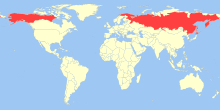Northern red-backed vole
| Northern red-backed vole | |
|---|---|
 |
|
| Scientific classification | |
| Kingdom: | Animalia |
| Phylum: | Chordata |
| Class: | Mammalia |
| Order: | Rodentia |
| Family: | Cricetidae |
| Genus: | Myodes |
| Species: | M. rutilus |
| Binomial name | |
|
Myodes rutilus (Pallas, 1779) |
|
 |
|
| Geographic range | |
The northern red-backed vole (Myodes rutilus) is a small slender vole found in Alaska, northern Canada, Scandinavia and northern Russia.
They have short slender bodies with a rust-colored back, light brown sides and underparts and a short thick tail. Their short ears are visible through their fur. They are 14 cm long with a 3.5 cm tail and weigh about 30 to 40 g. Their dental formula is 1/1, 0/0, 0/0, 3/3. They are active year-round, usually at night. They can cause damage to fruit trees and stored grains.
Northern red-backed voles live in a variety of northern forest and shrubland habitats. They occur in every major forest type in central Alaska. Plant species commonly found in areas occupied by northern red-backed voles include black spruce (Picea mariana), white spruce (P. glauca), quaking aspen (Populus tremuloides), paper birch (Betula papyrifera), alder (Alnus spp.), willow (Salix spp.), mountain cranberry (Vaccinium vitis-idaea), blueberry and bilberry (Vaccinium spp.), bunchberry (Cornus canadensis), and a variety of grasses and forbs. Important fungi, mosses and lichens include truffle (Endogone fascilulata), Schreber's moss (Pleurozium schreberi), mountain fern moss (Hylocomium splendens), sphagnum (Sphagnum spp.), and lichens (Cladonia and Peltigera spp.).
The breeding season of northern red-backed voles generally extends from May to August. Females are polyestrous and produce two or three litters during the breeding season. The first litter is produced in late May or early June.
Litter size ranges from four to nine. The average litter size is 5.93. Young northern red-backed voles are unable to regulate their temperature successfully until about 18 days. At this time they are weaned and leave the nest. Young grow little during the winter because of low food supplies. Age of sexual maturity depends to some extent on time of birth. About 20% of females from the first litter breed during the summer of birth. The remaining 80%, and later litters, breed the following May. Martell and Fuller found that the onset of summer breeding was related to the time of snowmelt. A late spring was followed by a low rate of maturation of young-of-the-year females.
In dense populations of northern red-backed voles, sexual maturation of young females may be delayed, or they may migrate to a vacant breeding space.
Northern red-backed voles are mainly nocturnal and crepuscular but are of necessity about during the prolonged arctic daylight season.
Northern red-backed voles are commonly found in northern shrub vegetation or open taiga forests. They also inhabit tundra. Northern red-backed voles are abundant on early successional sites as well as in mature forests. They occasionally inhabit rock fields and talus slopes.
...
Wikipedia

